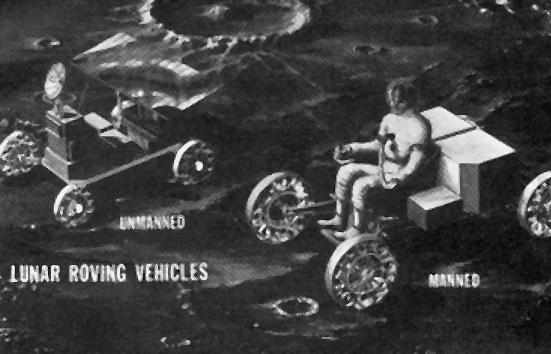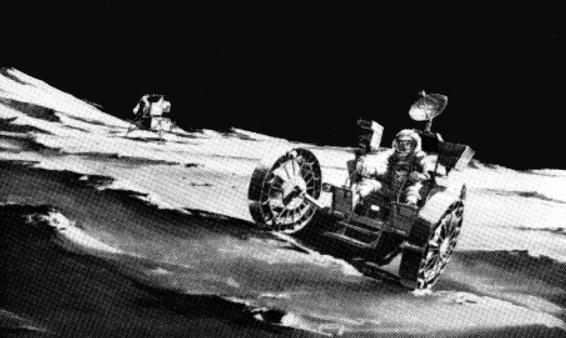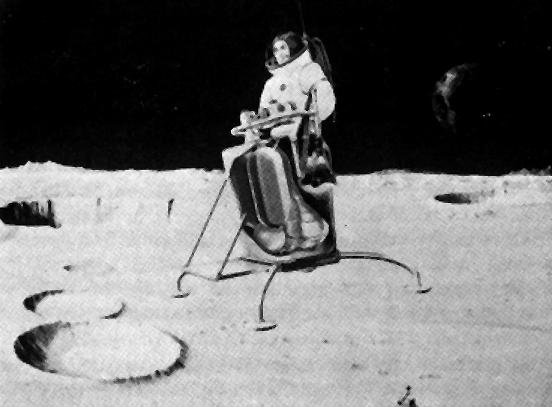
| Journal Home Page | Apollo 15 Journal |

| Journal Home Page | Apollo 15 Journal |
Journal Contributor Mick Hyde calls attention to the following from a lecture by E. F. M. Rees, then Deputy-Director, Technical, of the Marshall Space Flight Center, at the 11th International Science School for High School Students at the University of Sydney, 26 August to 6 September 1968 and published in the proceedings titled Man in inner and outer space edited by H. Messel and S. Butler (Shakespeare Head Press, Sydney 1968), pp223-392. The following extract comes from the chapter entitled 'The Future', which deals with projects - including Skylab, then under active development - that would follow the initial landing missions.
C. Lunar Surface Transportation "A small scientific base on the Moon will afford man the opportunity of exploring the lunar surface and studying its characteristics in a depth of detail. In support of that exploration, preliminary planning, including systems concept and design studies, have begun in representative areas such as scientific instrumentation, logistics systems, housing for extended stay-time and transportation while on the lunar surface.

"Studies have identified a design of the lunar roving vehicle (Figure 5-8) which could be transported to the lunar surface in one bay of the lunar module's descent stage. The vehicle would weigh about 500 pounds and be able to carry a suited astronaut plus a spare portable life support system and 300 pounds of scientific equipment over a five-mile radius area from the lunar module.
"The lunar roving vehicle could be adapted to remote controlled, unmanned operations. Once so adapted, it could be operated from Earth and could traverse 620 miles over the lunar surface, acquiring samples in preparation for a later visit by an astronaut. This concept keeps open several promising alternative develop-ments. For example, there may be a need to provide transportation for men and equipment between different sites on the Moon, to deploy scientific experiments for example, or to perform geological surveys.

"As stay time on the Moon increases, the need develops for larger wheeled vehicles such as the local scientific survey module (Figure 5-9), which could transport more equipment and also carry two astronauts, if desired. The survey module would be capable of manoeuvring in rougher terrains. Because of its size and weight the vehicle, along with other cargo, would be transported to the lunar surface by one launch while the astronauts would arrive on a later launch. The dual launch approach permits landing three to five times the cargo of the single launch approach and increases astronaut stay-time from 3 to 14 days.

"Another method of providing mobility on the Moon is through use of a small rocket-powered flying vehicle (Figure 5-10). This vehicle weighs approximately 150 pounds, has a propellant capacity of 230 pounds and, in addition to the astronaut, can carry up to 250 pounds of equipment and supplies. The range of this vehicle varies depending on distance to be traversed and the payload to be carried. Typically, it could travel about nine miles and return with one stop, or it could make a four-mile trip with a maximum payload. Propellants used are the same as for the lunar module: nitrogen tetroxide and 50-50 mixture of hydrazine and unsymmetrical dimethylhydrazine. The vehicle is refuelled on the Moon by exchanging tanks. Two throttleable 100 lb thrust rocket engines provide the required propulsion. The vehicle is controlled completely by the pilot and could provide rapid transportation for exploration of sites inaccessible to surface travel or could be used to rescue an astronaut stranded away from the base. Mobility systems such as these will significantly extend man's range of activities in the event that exploration of the lunar surface is begun."
| Journal Home Page | Apollo 15 Journal |